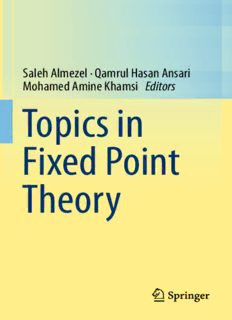
Topics in fixed point theory PDF
Preview Topics in fixed point theory
Saleh Almezel · Qamrul Hasan Ansari Mohamed Amine Khamsi Editors Topics in Fixed Point Theory Topics in Fixed Point Theory Saleh Almezel • Qamrul Hasan Ansari Mohamed Amine Khamsi Editors Topics in Fixed Point Theory 123 Editors SalehAlmezel QamrulHasanAnsari DepartmentofMathematics DepartmentofMathematics UniversityofTabuk AligarhMuslimUniversity Tabuk,SaudiArabia Aligarh,India MohamedAmineKhamsi DepartmentofMathematicalSciences UniversityofTexasatElPaso ElPaso,TX,USA ISBN978-3-319-01585-9 ISBN978-3-319-01586-6(eBook) DOI10.1007/978-3-319-01586-6 SpringerChamHeidelbergNewYorkDordrechtLondon LibraryofCongressControlNumber:2013951234 Mathematics Subject Classification: 06F30, 46B20, 46E30, 47H04, 47H05, 47H09, 47H10, 47H20, 47J20,47J25,47J30,47N10,49J40,49J53,54E40,54H25,54M20,58C30,65J15,65K10,90C26 ©SpringerInternationalPublishingSwitzerland2014 Thisworkissubjecttocopyright.AllrightsarereservedbythePublisher,whetherthewholeorpartof thematerialisconcerned,specificallytherightsoftranslation,reprinting,reuseofillustrations,recitation, broadcasting,reproductiononmicrofilmsorinanyotherphysicalway,andtransmissionorinformation storageandretrieval,electronicadaptation,computersoftware,orbysimilarordissimilarmethodology nowknownorhereafterdeveloped.Exemptedfromthislegalreservationarebriefexcerptsinconnection with reviews or scholarly analysis or material supplied specifically for the purpose of being entered and executed on a computer system, for exclusive use by the purchaser of the work. Duplication of this publication or parts thereof is permitted only under the provisions of the Copyright Law of the Publisher’slocation,initscurrentversion,andpermissionforusemustalwaysbeobtainedfromSpringer. PermissionsforusemaybeobtainedthroughRightsLinkattheCopyrightClearanceCenter.Violations areliabletoprosecutionundertherespectiveCopyrightLaw. Theuseofgeneraldescriptivenames,registerednames,trademarks,servicemarks,etc.inthispublication doesnotimply,evenintheabsenceofaspecificstatement,thatsuchnamesareexemptfromtherelevant protectivelawsandregulationsandthereforefreeforgeneraluse. While the advice and information in this book are believed to be true and accurate at the date of publication,neithertheauthorsnortheeditorsnorthepublishercanacceptanylegalresponsibilityfor anyerrorsoromissionsthatmaybemade.Thepublishermakesnowarranty,expressorimplied,with respecttothematerialcontainedherein. Printedonacid-freepaper SpringerispartofSpringerScience+BusinessMedia(www.springer.com) Preface Fixed point theory is one of the most powerful and fruitful tools of modern mathematics and may be considered a core subject of nonlinear analysis. In the last 50 years, fixed point theory has been a flourishing area of research for many mathematicians. The origins of the theory, which date to the later part of the nineteenth century, rest in the use of successive approximations to establish the existence and uniqueness of solutions, particularly to differential equations. This method is associated with many celebrated mathematicians like Cauchy, Fredholm,Liouville,Lipschitz,Peano,andPicard.Itisworthnotingthattheabstract formulationofBanachiscreditedasthestartingpointtometricfixedpointtheory. ButthetheorydidnotgainenoughimpetustillFelixBrowder’smajorcontribution tothedevelopmentofthenonlinearfunctionalanalysisasanactiveandvitalbranch of mathematics. In recent years a number of excellent books, monographs, and surveys by distinguished authors about fixed point theory have appeared. This monographisanattempttoexploresomeofitsaspectsafterthetheoryhasreached a level of maturityappropriate toan examination of itscentral themes. One of the objectivesofthismonographistoofferthemathematicalcommunityanaccessible self-containeddocumentwhichcanbeusedasanintroductiontothesubjectandits development. This monograph is composed of eight chapters on different aspects of the fixed point theory, namely, metric fixed point theory, Ekeland’s variation principle,hyperconvexmetricspaces,modularfunctionspaces,discretefixedpoint theory,topologicalfixedpointtheory,anditerativemethodsinfixedpointtheory. Each chapter is written by different authors who attempted to render the major resultsunderstandabletoawideaudience,includingnonspecialists,andatthesame time to provide a source for examples, references, open questions, and sometimes new approaches for those currently working in this area of mathematics. This monograph should be of interest to graduate students seeking a field of interest, tomathematiciansinterestedinlearningaboutthesubject,andtospecialists. We thank collectively our many friends and colleagues who, through their encouragement and help, influenced the development of this book. In particu- lar, we are grateful to the Rector of the University of Tabuk Dr. Abdulaziz S.Al-EnaziandtheViceRectorforpostgraduatestudiesandscientificresearchProf. v vi Preface F.Al-SolamyfortheirsupportintheorganizationoftheInternationalMathematical WorkshoponFixedPointTheoryandApplications,May2012.Mostoftheauthors whocontributedinthismonographattendedthisworkshopandagreedtobepartof thisproject.SpecialthanksgotoMs.KaitlinLeach(AssociateEditor,Mathematics, Springer)forherinteresttopublishthismonograph. Tabuk,SaudiArabia SalehAlmezel Aligarh,India QamrulHasanAnsari ElPaso,TX,USA MohamedAmineKhamsi Contents 1 IntroductiontoMetricFixedPointTheory............................... 1 M.A.Khamsi 1.1 Introduction............................................................ 1 1.2 MetricFixedPointTheory............................................ 2 1.3 Caristi–EkelandExtension............................................ 3 1.4 TheConverseProblem ................................................ 4 1.5 SomeApplications..................................................... 5 1.5.1 ODEandIntegralEquations................................. 5 1.5.2 CantorandFractalSets...................................... 6 1.6 HistoricalNote......................................................... 6 1.7 MetricFixedPointTheoryinBanachSpaces........................ 7 1.7.1 ClassicalExistenceResults.................................. 8 1.7.2 TheNormalStructureProperty.............................. 10 1.7.3 MoreonNormalStructureProperty ........................ 11 1.7.4 NormalStructureandSmoothness.......................... 13 1.7.5 Karlovitz–GoebelLemma................................... 14 1.8 NonstandardTechniques .............................................. 14 1.8.1 ExtendingMappingstoUltrapowers........................ 15 1.9 MoreonMetricFixedPointTheoryinMetricSpaces............... 17 1.9.1 MengerConvexityinMetricSpaces........................ 17 1.9.2 UniformlyConvexMetricSpaces........................... 19 1.9.3 FixedPointPropertyinUniformlyConvex MetricSpaces ................................................ 22 1.10 TheConvexityStructures ............................................. 24 1.10.1 HyperconvexMetricSpaces................................. 25 References..................................................................... 29 2 BanachContractionPrincipleandItsGeneralizations.................. 33 AbdulLatif 2.1 Introduction............................................................ 33 2.2 Contractions:DefinitionandExamples............................... 33 vii viii Contents 2.3 TheBanachContractionPrinciplewithSome Applications............................................................ 35 2.4 SomeOtherExtensionsofBCPforSingle-ValuedMappings....... 40 2.5 Caristi’sFixedPointTheorem ........................................ 47 2.6 SomeExtensionsofBCPUnderGeneralizedDistances............. 48 2.7 MultivaluedVersionsofBCP......................................... 51 References..................................................................... 61 3 Ekeland’sVariationalPrincipleandItsExtensions withApplications............................................................. 65 QamrulHasanAnsari 3.1 Introduction............................................................ 65 3.2 Ekeland’sVariationalPrincipleinComplete MetricSpaces.......................................................... 66 3.3 ApplicationstoFixedPointTheorems ............................... 75 3.4 ApplicationstoOptimization ......................................... 80 3.5 ApplicationstoWeakSharpMinima ................................. 84 3.6 Equilibrium Problems and Extended Ekeland’s VariationalPrinciple................................................... 87 3.6.1 EquilibriumProblems ....................................... 87 3.6.2 ExtendedEkeland’sVariationalPrinciple .................. 88 AppendixA.................................................................... 96 References..................................................................... 96 4 FixedPointTheoryinHyperconvexMetricSpaces...................... 101 RafaelEspínolaandAuroraFernández-León 4.1 IntroductionandBasicDefinitions.................................... 101 4.2 SomeBasicPropertiesofHyperconvexMetricSpaces.............. 108 4.3 Hyperconvexity,Injectivity,andRetractions......................... 114 4.4 Isbell’sHyperconvexHull............................................. 120 4.5 TopologicalFixedPointPropertyandHyperconvexity.............. 127 4.6 MetricFixedPointPropertyandHyperconvexity.................... 134 4.7 MetricFixedPointPropertyforMultivaluedMappings andNonexpansiveSelections ......................................... 137 4.8 KKMTheoryandHyperconvexSpaces.............................. 140 4.9 FixedPointTheoryandR-Trees...................................... 144 4.10 NewTrendsinHyperconvexity....................................... 151 4.10.1 TwoLong-StandingOpenProblems........................ 151 4.10.2 UltrametricsandHyperconvexMetricSpaces.............. 152 4.10.3 DiversitiesandHyperconvexity............................. 152 4.10.4 Q-hyperconvexity............................................ 154 References..................................................................... 155 5 AnIntroductiontoFixedPointTheory inModularFunctionSpaces................................................ 159 W.M.Kozlowski 5.1 Introduction............................................................ 159 Contents ix 5.2 ModularFunctionSpacesandModularGeometry................... 161 5.2.1 IntroductiontoModularFunctionSpaces .................. 162 5.2.2 GeometricalPropertiesofModularFunctionSpaces ...... 170 5.2.3 NonlinearMappingsinModularFunctionSpaces ......... 183 5.3 ExistenceofFixedPoints ............................................. 186 5.3.1 GeneralizedContractionsinModularFunctionSpaces.... 186 5.3.2 GeneralizedNonexpansiveMappings....................... 193 5.4 ConvergenceofFixedPointIterativeAlgorithms.................... 200 5.5 SemigroupsofMappingsinModularFunctionSpaces.............. 214 References..................................................................... 219 6 FixedPointTheoryinOrderedSetsfromtheMetric PointofView.................................................................. 223 M.Z.Abu-SbeihandM.A.Khamsi 6.1 Introduction............................................................ 223 6.2 GeneralizedMetricSpaces............................................ 224 6.3 TheRetractionProperty............................................... 228 6.4 FixedPointProperty................................................... 230 6.5 ExternallyCompleteSets ............................................. 233 References..................................................................... 235 7 SomeFundamentalTopologicalFixedPointTheorems forSet-ValuedMaps......................................................... 237 HichemBen-El-Mechaiekh 7.1 IntroductionandPreliminaries........................................ 237 7.1.1 Elementary Proofs of the Brouwer andSchauder–TychonoffFixedPointTheorems........... 239 7.2 KyFanandKakutaniMaps ........................................... 243 7.2.1 KyFanMaps................................................. 244 7.2.2 KakutaniMaps............................................... 245 7.3 ContinuousSelectionsandApproximations ......................... 246 7.3.1 ContinuousSelectionsforKyFanMaps.................... 246 7.3.2 ContinuousApproximationsofKakutaniMaps............ 247 7.4 TheBrowder–KyFanandtheKakutani–KyFanFixed PointTheoremsandTheirConsequences ............................ 249 7.4.1 TheBrowder–KyFanFixedPointTheorem................ 249 7.4.2 TheKakutani–KyFanFixedPointTheorem ............... 250 7.4.3 CoincidenceTheorems ...................................... 251 7.5 RelaxingCompactnessandRelatedResults.......................... 254 7.5.1 TheCoercivityCondition(κ)............................... 254 7.5.2 IntersectionTheorems:KKMandMatching ............... 256 7.5.3 Browder–KyFanTheoremonStar-ShapedDomains...... 258 7.5.4 ALeray–SchauderAlternativeforKakutaniMaps......... 259 7.6 SystemsofNonlinearInequalitiesandApplications................. 262 7.7 ConcludingRemarks .................................................. 269 References..................................................................... 270
Description: